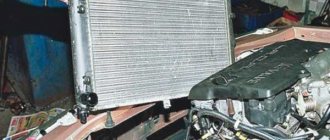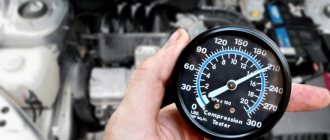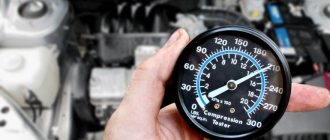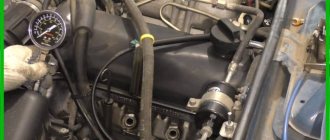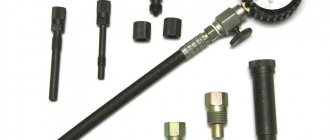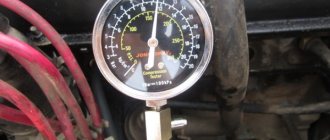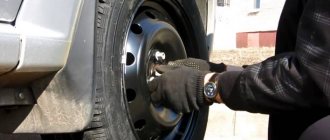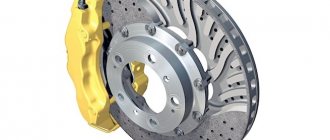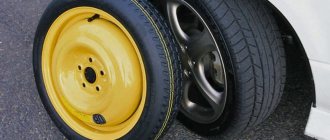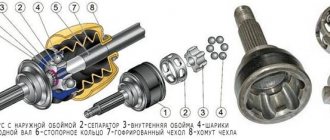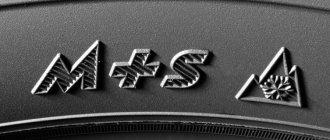VAZ 2110 is one of the most popular Russian models. The cost of consumables for Russian cars is usually cheap, and you can always save a lot. But there are components on which it is not worth saving; it will cost you more. These components include the brake system.
The basis of the braking system is the brake disc. Disc brakes on the VAZ 2110 are installed only on the front axle, which is where the main force during braking occurs.
Wheels on the VAZ 2110 are divided, depending on the engine, as follows:
- 8 valve VAZ 2110 engines are equipped with R13 brake discs
- 16 valve VAZ 2110 engines are equipped with R14 brake discs
Due to the low cost, many people do not hesitate to install original disks:
- 2108-3501070 — front brake disc r13, not ventilated, cost from 898 rubles.
Today, perhaps, the most unfortunate and unacceptable option. Due to the lack of ventilation, the disc is susceptible to overheating , which means the brake fluid will overheat and boil; this can be clearly felt when the pedal begins to go down. When brake fluid boils, the effectiveness of the brakes drops sharply and you risk being left without brakes at all.
- 2110-3501070 — front ventilated brake disc r13, cost from 3,758 rubles.
An improved version of the previous disc. The main improvement is the appearance of ventilation. The discs do not heat up so much and behave well during quiet driving.
- 2112-3501070 — front ventilated brake disc r14, cost from 919 rubles.
Perhaps the best option among the original discs. Here you have ventilation and an increased contact area with the block. Consequently, you have a lower chance of disc overheating and improved braking properties compared to previous options. Despite their advantages, such discs are not suitable for a driving style with constant brake loads, but remain reliable and comfortable brakes for quiet, everyday driving.
But the choice is not limited to originals. The VAZ 2110 is a popular model and a large number of analogue brake discs are produced for it. So, if you want to save money, you can take BM BD 5222.
- BM BD5222 front brake disc r13, not ventilated, cost from 512 rubles.
- BM BDV221 front ventilated brake disc r13, price from 622 rubles.
- BM BDV220 front ventilated brake disc r14, price from 842 rubles.
BM discs are made in China, and you can't count on improved braking quality. The main advantage of these discs is the price, which in percentage terms is significantly lower than the original discs. But due to the low cost of original disks, the real savings are negligible and it is better to overpay slightly and install original disks.
Thus, there is no point in chasing cheapness, but you can choose an analogue to improve the quality of braking, but here you will have to overpay in comparison with the original ones.
- TRW DF1748 front brake disc r13, not ventilated, cost from 893 rubles.
- TRW DF4108 front ventilated brake disc r13, cost from 920 rubles.
- TRW DF4107 front ventilated brake disc r14, price from 1013 rubles.
TRW is a good option. The brakes under normal conditions are comparable to the originals, but in extreme conditions they behave much better. The discs withstand overheating better , cool faster and provide better braking.
- Brembo 08.5211.10 front brake disc R13, not ventilated, cost from 784 rubles.
- Brembo 09.8894.14 front ventilated brake disc r13, cost from 1100 rubles.
- Brembo 09.8903.14 front ventilated brake disc r14, price from 1063 rubles.
Many people choose Brembo for their sporting history. Brembo discs are a truly high-quality product, although it is far from their sports developments. But the VAZ is not a sports car, so Brembo wheels fully meet the requirements of the car . Brembos withstand overheating well and provide excellent braking in all conditions.
- Ate 24.0112-0125.1 front brake disc r13, not ventilated, cost from 990 rubles.
- Ate 24.0120-0186.1 front ventilated brake disc r13, cost from 1590 rubles.
- Ate 24.0120-0187.1 front ventilated brake disc r14, price from 1596 rubles.
Ate is significantly more expensive than the original discs. But there is something to pay for: high quality materials, comfortable and predictable braking in any conditions, resistant to overheating and deformation. And most importantly, everyone who decided to install them is very satisfied with both the new brakes and their service life.
Prices are indicated for Moscow and the region as of winter 2016.
Source etlib.ru
This article will help answer all the questions about switching from one brake to another. It will also help you figure out what kind of brakes you currently have. To do this, consider the stock front brakes for front-wheel drive VAZ: 2108-21099, 2110-2112, 2113-2115, Kalina, Priora, Granta
R13 not ventilated
They were installed on the SAMAR and SAMAR-2 families, as well as on the 10th family (only with an 8-liter carburetor engine).
Explosion diagram Caliper
Visually, they can be distinguished by the lack of ventilation on the brake discs, in addition to the characteristic 2108 boot.
R13 ventilated
They were placed on families 10, Kalin, Grant exclusively with 8kl.
engine. Explosion diagram Caliper
Visually, it is easy to distinguish from 08 by a wider disk with ventilation. Brakes from R14 can be visually distinguished by the brake disc boot ratio.
R14 ventilated
They were installed on families 10, Prior (even with 8kl. ICE), Kalin, Grant with 16kl.
engine. Explosion diagram Caliper
Visually easily determined by the ratio of the brake disc boot. The disc will completely cover the boot. There is another option, remove the fixed bracket and 2112 should be stamped on it. In addition, it is simply impossible to install wheels of 13 radius.
R15 ventilated
They were placed on the Kalin and Grant families from 16kl.
engine in the sport version. Explosion diagram
Standard R13″ ventilated calipers are used (movable caliper 2110, fixed caliper 2110 which is machined to fit a wider brake disc).
And to extend the guide to a larger radius, the plant uses “bone” adapters
When installing them, you need to file the ears on the fist
There is another option that is almost factory-made. Install the Volga calipers using a special spacer. They have their own brake pad, which, in addition to everything, has an even larger area compared to the VAZ one.
RESULT:
1) When moving from R13 non-ventilated to R13 ventilated, you will need: - Caliper bracket 2110 movable 2110-3501017 - Caliper bracket 2110 fixed 2110-3501155 - Brake disc housing right VAZ-2110 (14 inches) 2112-3501146 - Brake disc housing left VA Z -2110 (14 inches) 2112-3501147 — Brake disc VAZ 2110 (13 inches) 2110-3501070 As you can see, we will need brackets, boots and the brake discs themselves. You can leave the old calipers.
2) When moving from R13 non-ventilated to R14 ventilated, you will need: - Caliper bracket 2110 movable 2110-3501017 - Caliper bracket 2112 fixed 2112-3501155 - Brake disc housing right VAZ-2110 (14 inches) 2112-3501146 - Brake disc housing left VA Z -2110 (14 inches) 2112-3501147 — Brake disc VAZ 2112 (14 inches) 2112-3501070 As you can see, we will need brackets, boots and the brake discs themselves. You can leave the old calipers.
3) When switching from R13 ventilated to R14 ventilated, you will need: - Caliper bracket 2112 fixed 2112-3501155 - Brake disc VAZ 2112 (14 inches) 2112-3501070 As you can see, we only need a movable bracket and the brake discs themselves. The calipers can be left as old, the boots were originally designed for R14 brakes, the movable caliper remains the same.
4) When switching to R15 ventilated ones, you will need: - Movable caliper bracket 2110 2110-3501017 (but it needs to be sharpened) - Fixed caliper bracket 2112 2112-3501155 (only if you have R13 not ventilated) - Spacer for the fixed bracket - Disc 15 inch brake
IMPORTANT: after installing R14 brakes, you will definitely have to switch to R14 wheels or a larger radius!
Minimum permissible thickness of brake discs:
For ventilated 17.8 mm For non-ventilated 10.8 mm
Brake pads
For all the brakes described above, there is only one type of pad - 2108. All other differences: (the presence of a wear sensor, friction material,
but not thickness
, its location, various grooves and grooves already depend on the manufacturer).
From personal experience I will say that after switching to R13 ventilated brakes, braking became more effective, squeals when braking almost disappeared. Due to better cooling of the brake disc, its volume and weight increase and heat dissipation becomes faster. When switching to R14, braking becomes even better, especially noticeable at high speeds, due to the increase in the friction surface (the volume and mass of the disc still increases) and the removal of the point from the center of rotation (to put it roughly and simply, the “effect of increasing the shoulder”). If you install a brake disc with perforations and grooves, the braking performance will further increase due to the removal of water and friction material of the brake pad from the contact patch.
Source www.drive2.ru
The brake disc of a car, working in intensively stressful conditions and in unfavorable external conditions, ensures the safety of our movement. This axiom. But, while performing complex and responsible work, the disc itself, seemingly made of strong material, remains very vulnerable to damage by a part of the brake system.
Examination
Having carried out all the above operations - first on one wheel, and then on the second, you also need to check the system for leaks. The first phase is to simply press the pedal.
The fact that everything is done normally is indicated by the fact that the pedal is pressed with force, quite tightly.
But this is not enough. Have someone else press the brake pedal while you try to rotate the parts that make up your new rear disc brakes.
If nothing moves, it means that your VAZ 2110 now has new rear disc brake systems - better and more reliable than the previous ones.
To minimize the braking distance, it is recommended to install a vacuum booster. Details: https://vazweb.ru/desyatka/tormoza/vakuumnyi-usilitel-tormozov.html
Installation
It's time to install disc brakes instead of the removed rear drum brakes.
Having knocked off the hub, we will put it back, but in a different way:
- It should be installed through the plate into which the caliper is already mounted. Carefully ensure that all holes line up. Particular attention to alignment;
- Next, use a hammer to straighten the corner of the beam so that the caliper does not rest against it;
- Now you can put the brake disc on the hub, placing spacers between these parts, and secure the disc with a bracket;
- We install brake pads from VAZ 2110;
- First, carefully and securely attach the brake hose to the caliper, and then to the tube;
- To reduce the braking force of the rear brakes compared to the front, you need to partially grind off the friction material of the pads.
Front drive brakes VAZ
This article will help answer all the questions about switching from one brake to another.
It will also help you figure out what kind of brakes you currently have. To do this, consider the stock front brakes for front-wheel drive VAZ: 2108-21099, 2110-2112, 2113-2115, Kalina, Priora, Granta R13 not ventilated
They were installed on the SAMAR and SAMAR-2 families, as well as on the 10th family (only with an 8-liter carburetor engine).
Explosion diagram Caliper
Visually, they can be distinguished by the lack of ventilation on the brake discs, in addition to the characteristic 2108 boot.
R13 ventilated
They were placed on families 10, Kalin, Grant exclusively with 8kl.
engine. Explosion diagram Caliper
Visually, it is easy to distinguish from 08 by a wider disk with ventilation. Brakes from R14 can be visually distinguished by the brake disc boot ratio.
R14 ventilated
They were installed on families 10, Prior (even with 8kl. ICE), Kalin, Grant with 16kl.
engine. Explosion diagram Caliper
Visually easily determined by the ratio of the brake disc boot. The disc will completely cover the boot. There is another option, remove the fixed bracket and 2112 should be stamped on it. In addition, it is simply impossible to install wheels of 13 radius.
R15 ventilated
They were placed on the Kalin and Grant families from 16kl.
engine in the sport version. Explosion diagram
Standard R13″ ventilated calipers are used (movable caliper 2110, fixed caliper 2110 which is machined to fit a wider brake disc).
And to extend the guide to a larger radius, the plant uses “bone” adapters
When installing them, you need to file the ears on the fist
There is another option that is almost factory-made. Install the Volga calipers using a special spacer. They have their own brake pad, which, in addition to everything, has an even larger area compared to the VAZ one.
RESULT:
1) When moving from R13 non-ventilated to R13 ventilated, you will need: - Caliper bracket 2110 movable 2110-3501017 - Caliper bracket 2110 fixed 2110-3501155 - Brake disc housing right VAZ-2110 (14 inches) 2112-3501146 - Brake disc housing left VA Z -2110 (14 inches) 2112-3501147 — Brake disc VAZ 2110 (13 inches) 2110-3501070 As you can see, we will need brackets, boots and the brake discs themselves. You can leave the old calipers.
2) When moving from R13 non-ventilated to R14 ventilated, you will need: - Caliper bracket 2110 movable 2110-3501017 - Caliper bracket 2112 fixed 2112-3501155 - Brake disc housing right VAZ-2110 (14 inches) 2112-3501146 - Brake disc housing left VA Z -2110 (14 inches) 2112-3501147 — Brake disc VAZ 2112 (14 inches) 2112-3501070 As you can see, we will need brackets, boots and the brake discs themselves. You can leave the old calipers.
3) When switching from R13 ventilated to R14 ventilated, you will need: - Caliper bracket 2112 fixed 2112-3501155 - Brake disc VAZ 2112 (14 inches) 2112-3501070 As you can see, we only need a movable bracket and the brake discs themselves. The calipers can be left as old, the boots were originally designed for R14 brakes, the movable caliper remains the same.
4) When switching to R15 ventilated ones, you will need: - Movable caliper bracket 2110 2110-3501017 (but it needs to be sharpened) - Fixed caliper bracket 2112 2112-3501155 (only if you have R13 not ventilated) - Spacer for the fixed bracket - Disc 15 inch brake
IMPORTANT: after installing R14 brakes, you will definitely have to switch to R14 wheels or a larger radius!
Minimum permissible thickness of brake discs:
For ventilated 17.8 mm For non-ventilated 10.8 mm
Brake pads
For all the brakes described above, there is only one type of pad - 2108. All other differences: (the presence of a wear sensor, friction material,
but not thickness
, its location, various grooves and grooves already depend on the manufacturer).
From personal experience I will say that after switching to R13 ventilated brakes, braking became more effective, squeals when braking almost disappeared. Due to better cooling of the brake disc, its volume and weight increase and heat dissipation becomes faster. When switching to R14, braking becomes even better, especially noticeable at high speeds, due to the increase in the friction surface (the volume and mass of the disc still increases) and the removal of the point from the center of rotation (to put it roughly and simply, the “effect of increasing the shoulder”). If you install a brake disc with perforations and grooves, the braking performance will further increase due to the removal of water and friction material of the brake pad from the contact patch.
Content
Description of front brakes
Which brake discs are best for VAZ 2110 and 2114? To answer this question, you need to decide what type of disk and where it is installed. Disc brakes on the 2110 and 2114 are installed only on the front wheels; drums are used at the rear. The design uses non-ventilated discs. There is also automatic adjustment of the gap between the disc and pads.
There is also a brake pad wear sensor. If you decide to change these parts due to increased wear, then be sure to pay attention to the caliper. It may be faulty, which leads to increased wear on the disc. Be sure to find and eliminate the cause of the problem.
Examination of brake discs for VAZ-2110. Disco for "ten"
Approximate price – 1240 rubles.
“Togliatti”, fortunately, did not disgrace itself - only deviations in the beating of the working surface can be called a fly in the ointment, but the balancing is the most accurate. The “water procedures” of the discs also went well and were effective.
I’m leaving the entrance, and in the parking lot my neighbor is warming up his car. And straight to the point: “I changed the brake discs over the weekend - installed ventilated ones!” - boasts. - “Which ones?” -“Ventilated! Previously they were standard, but now they have holes and grooves. Here!"
Approximate price – 1600 rubles. “German” took an intermediate position between good and bad... Before the tests - no complaints, but after the heated disk was lowered into water, impressive cracks appeared on the metal, and the parallelism norm turned out to be
The neighbor is mistaken, of course. On front-wheel drive VAZs, ventilated discs are installed initially on the conveyor. After all, the speeds, and therefore the loads on the braking system of modern cars, have increased, and non-ventilated brake discs can no longer cope with the increased temperature of the rubbing surfaces. Here come the brake discs, cast with voids and stiffening ribs that improve cooling. But on standard VAZ parts there are no perforations or grooves - these are, so to speak, additional design features that allow the disks to withstand even greater temperature loads. Like, for example, sports cars.
Since the VAZ 2110 has long become a sports car for many of our compatriots, perforated wheels for these cars also shine with polished metal on the shelves of auto parts stores.
Approximate price – 1450 rubles. Cons: initially the norm for static imbalance was exceeded three times. After cooling with water, the parallelism and runout standards were exceeded by 2.5 and two times, respectively. Cracks have formed near the perforations
Be an expert! We bought a set of LGR perforated wheels and, of course, couldn’t resist comparing them with the standard ones manufactured in Togliatti, and also, to complete the picture, with imported German ones from Lucas. The tests were carried out, as expected, at NAMI. In addition to the usual parameters - geometric dimensions, static imbalance and hardness of the working surfaces, it was decided to determine the tendency to warp when a heated disk is cooled with water. It happens that in rainy weather, after prolonged braking, willy-nilly you have to swim across a deep puddle. After such a “Camel Trophy”, the steering wheel often shakes when braking - the discs swerved... So, when cooling with water, cracks appeared on the Lucas and LGR discs. The Togliatti fighter did not give up!
As a result of the examination, it turned out that the Togliatti brake disc has deviations in the runout of the working surface, but, oddly enough, the best balancing. The worst for balancing is the perforated disc, which, according to experts, is most likely due to careless drilling of the perforations.
The wear resistance of all types of discs is approximately the same, as well as the wear resistance of the pads themselves when working with domestic and imported discs. But on a perforated disc, pad wear is significantly lower.
The braking efficiency (braking distance) of the domestic disc is slightly better than that of the others, but the perforated ones have an advantage when working in high-temperature zones. So, on the 25th braking, the temperature for non-perforated discs rose to 350–360°C, for perforated discs – to 280°C.
In the end, everything is like with people: each brake disc has its own advantages and disadvantages. But let’s answer the main question of the examination: is it worth installing perforated disks on the “ten”? Experts believe that perforation in the inherent range of temperatures, pressures and speeds of the VAZ 2110 not only does not provide significant advantages, but also worsens a number of characteristics, while increasing the cost of the product. Is it worth bragging?
Stories from our readers
“Fucking basin. "
Hi all! My name is Mikhail, now I’ll tell you a story about how I managed to exchange my two-wheeler for a 2010 Camry. It all started with the fact that I began to be wildly irritated by the breakdowns of the two-wheeler, it seemed like nothing serious was broken, but damn it, there were so many little things that really started to irritate me. This is where the idea arose that it was time to change the car to a foreign car. The choice fell on the melting Camry of the tenth years.
Yes, I had matured morally, but financially I just couldn’t handle it. I’ll say right away that I am against loans and taking a car, especially not a new one, on credit is unreasonable. My salary is 24k a month, so collecting 600-700 thousand is almost impossible for me. I started looking for different ways to make money on the Internet. You can’t imagine how many scams there are, what I haven’t tried: sports betting, network marketing, and even the volcano casino, where I successfully lost about 10 thousand ((The only direction in which it seemed to me that I could make money was currency trading on the stock exchange, they call it Forex. But when I started delving into it, I realized that it was very difficult for me. I continued to dig further and came across binary options. The essence is the same as in Forex, but it’s much easier to understand. I started reading forums, studying trading strategies. I tried it on a demo account, then opened a real account. To be honest, I didn’t manage to start earning money right away, until I understood all the mechanics of options, I lost about 3,000 rubles, but as it turned out, it was a precious experience. Now I earn 5-7 thousand rubles a day. I managed to get the car buy after half a year, but in my opinion this is a good result, and it’s not about the car, my life has changed, I naturally quit my job, I have more free time for myself and my family. You’ll laugh, but I work directly on the phone)) If If you want to change your life like me, then here’s what I advise you to do right now: 1. Register on the site 2. Practice on a Demo account (it’s free). 3. As soon as you get something on the Demo account, top up your REAL ACCOUNT and go to REAL MONEY! I also advise you to download the application to your phone, it’s much more convenient to work from your phone. Download here.
Minimum permissible thickness of brake discs:
- For ventilated 17.8 mm
- For non-ventilated 10.8 mm
Brake discs are distinguished:
- Ventilated discs
- With gas outlets
- With perforation or grooves (slots)
- Collapsible
Let's look at each point in more detail.
The first option is ventilated discs . They are two separate disks, fastened together in such a way that they resemble blades (like a turbine). Thanks to these blades and channels, heat is dissipated more efficiently and the weight of the disc is reduced. Example of simple ventilated brake discs .
During active braking, if the brake discs are not cooled enough, their temperature can reach 180-250 degrees. Regular pads start to smoke. The gas released when the pads rub against the heated disc serves as a layer between the disc and the pad and prevents the pads from fitting tightly to the brake disc. This is the main problem why braking disappears . To prevent such cases, there are gas outlets, perforations and grooves. An example of brake discs with gas outlets .
Another reason for brake failure can be carbon deposits on the pads, which appears during frequent braking (on a race track). This carbon deposit turns the block into a slippery ski. Gas outlets and perforations cut off this slippery layer, renewing the pad. But they make brake pads wear out faster . Example of brake discs with perforations and grooves .
In addition, perforations together with grooves help remove water, dirt, and dust, which reduces the risk of scratching the brake disc. They also increase additional braking force and reduce disc wear . An example of brake discs with gas outlets and perforations .
The fourth option is collapsible disks . As we already know, when braking, the brake discs heat up and the heat is transferred to the hub, and at high temperatures this unit is likely to fail. This is why some companies offer collapsible brake discs . They are a working disk, which is bolted to the middle part, which is attached to the hub. An example of dismountable brake discs .
Because The majority of car owners operate their cars on city roads, and not on ring tracks and races, then the effectiveness of standard brakes will be sufficient . If you still want to improve the car's braking system , then you should not install rear disc brakes, but rather change the brake discs to a larger diameter and install perforated brake discs . You will feel the difference immediately, not only in braking, but also in the appearance of your car (for example, by illuminating perforated wheels with LEDs).
